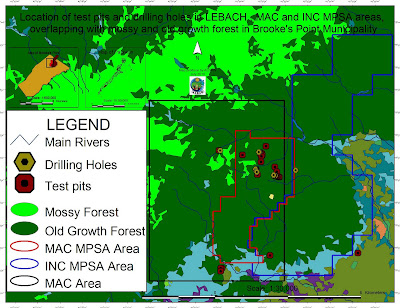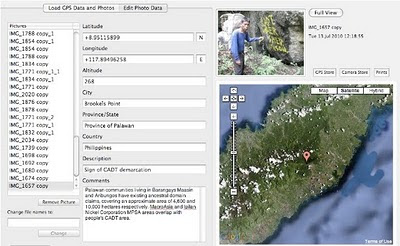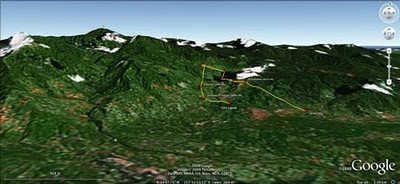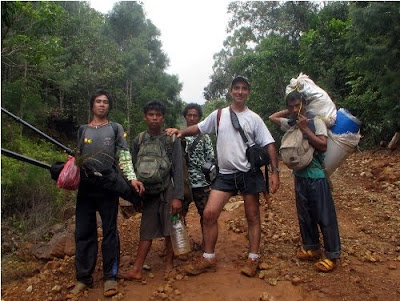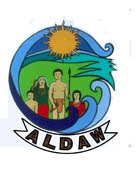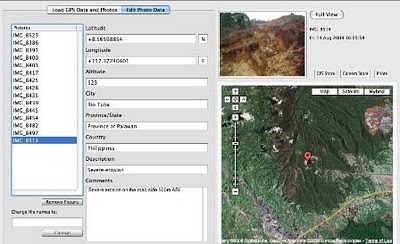Agrofuels in Palawan, as elsewhere in the Philippines, have been portrayed as a key solution to lower greenhouse gas emission, achieve energy independence, as well as a tool for poverty eradication. With these objects in mind, the Provincial Government of Palawan is strongly promoting agrofuels development, without taking into account the socio-ecological impact of such mono-crop plantations. As a result, thousands of hectares of lands in the province have been set aside for jatropha feedstock and oil palm.
Oil palm plantations, in Palawan, are being established by the Agumil Philippines Inc., a joint venture between Filipino and Malaysian investors, that also engages in the processing of palm oil. The LandBank of the Philippines is backing the project financially.
The local indigenous network ALDAW (Ancestral Land Domain Watch), in collaboration with other local organizations and Palawan NGOs, is making a call for the implementation of more restrictive regulations on oil palm expansion to halt deforestation, habitat destruction, food scarcity, and violation of indigenous peoples’ rights. In addition to this, oil palm plantations are also expanding into the indigenous fallow land (benglay), thus reducing the number of rotational areas needed for the swidden cycle. As of now, the Palawan municipality of Española has the highest percentage of oil palms, and plantations are fast expanding also to other municipalities such as Brooke’s Point, Bataraza, Rizal, Quezon, etc. In some municipalities, oil palms are already competing and taking over cultivated areas (e.g. rice fields), which are sustaining local self-sufficiency.
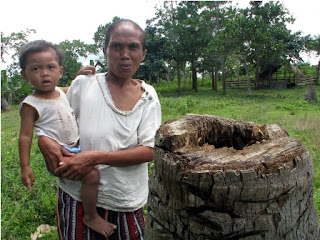 “LandBank’s contribution to President Aquino’s commitment to develop the rural economy and to raise farmers’ income should not include oil palms development. It is well known that this crop benefits better-off farmers and entrepreneurs, rather then small-scale farmers and indigenous peoples. We look forward to more sustainable investments for improving agricultural productivity of marginalized farmers. Meanwhile, a moratorium on oil palm expansion should be implemented with haste” said Artiso Mandawa, ALDAW Chairman.
“LandBank’s contribution to President Aquino’s commitment to develop the rural economy and to raise farmers’ income should not include oil palms development. It is well known that this crop benefits better-off farmers and entrepreneurs, rather then small-scale farmers and indigenous peoples. We look forward to more sustainable investments for improving agricultural productivity of marginalized farmers. Meanwhile, a moratorium on oil palm expansion should be implemented with haste” said Artiso Mandawa, ALDAW Chairman.In the community of Iraray II (Municipality of Española) indigenous people complain that a ‘new’ pest has spread from the neighboring oil palm plantations to their cultivated fields devouring hundreds of coconut palms by boring large networks of tiny tunnels into the palms’ trunks. Local indigenous people showed specimens of this pest to ALDAW mission members, and the insect was later identified as the Red Palm Weevil (Rhynchophorus ferrugineus). The red weevil is reported to be a native of south Asia, however, the Palawan of Iraray II claims that they only began to experience massive pest attacks on their coconut groves, after oil palms were introduced into the area at the expense of the local population of buri palms (Corypha elata). The latter is a popular basketry material for both the local Palawan and farmer communities. The trunk of this palm contains edible starch. The bud (ubud) is also edible raw or cooked, as well as the kernels of the nuts.
ALDAW preliminary findings, obtained in collaboration with the Centre for Biocultural Diversity (CBCD) – University of Kent, indicate there is a scarcity of public records showing the processes and procedures leading to the issuance of land conversion permits and environmental clearances to oil palm companies, as well as to the local cooperatives created in the various barangays. Moreover, ALDAW is also in the process of mapping all oil palm locations in Palawan, through the use of geotagging technologies. Evidence indicates that – in most cases - members of indigenous communities, who have ‘rented’ portions of their land to the oil company, have no clear understanding of the nature of such ‘agreements’ nor they possess written contracts countersigned by the company. There is a risk that members of local communities who have joined the so-called ‘cooperatives’ will soon become indebted with the oil company. In fact they provide very cheap labor and also barrow funds to purchase fertilizer, pesticides and equipment, while the company controls every aspect of production.
Overall, it would appear that land conversion into oil palm plantations is happening with little or no monitoring on the part of those government agencies (e.g. Palawan Council for Sustainable Development) that are responsible for the sustainable management of the Province.
The new trend in the Philippine Market: switching from coconut to palm oil
There is a new trend in the Philippines, leading to the acceleration of oil palm expansion. National vegetable oil millers and refiners are now keen on selling the cheaper palm oil for the domestic market, so that all coconut oil would be exported. Coconut oil, in fact, commands a higher premium in the international market. However, contrary to oil palms, coconut cultivation is endemic to the Philippines and this palm provides multiple products to local farmers, thus sustaining household based economy.
Since 2005, cooking oil manufacturers have increased imports of the cheap palm oil by 90 percent. The use of the palm oil has progressively increased in the local market as household consumers and institutional buyers have preferred it because of the price difference compared with edible coconut oil. Fast-food giants such as Jollibee Foods Corp., have switched to palm oil for their business.
The General Context of Oil Palm Development
Crude palm oil (CPO) consumption worldwide has doubled between 2000 and 2010 with the main new demand coming from Eastern Europe, India and China. By and large, the price of palm oil has increased almost steadily over the past 20 years. Two countries in South East Asia, Malaysia and Indonesia, produce over 80% of the internationally traded CPO. While significant expansion is occurring in Thailand, Papua New Guinea, Costa Rica, Colombia, Ecuador, Cameroon, the Democratic Republic of Congo and it is now taking over in the Philippines. Currently there are an estimated 4 million hectares of land under oil palms in Malaysia and over 7.5 million hectares in Indonesia. In Peninsular Malaysia, the palm oil frontier has come near to the limits of land availability and most expansion within Malaysia is now in the two Eastern States of Sabah and Sarawak. Much of the investment for oil palm expansion has come from European Banks but, increasingly, funds are being raised from Islamic banks in the Middle East, and from investors from India and China. It has been estimated that about two thirds of the companies opening lands to plant oil palm in Indonesia are majority-owned by Malaysian conglomerates
The economies of scale and the characteristics of oil palm favor the development of large plantations, meaning that land needs to be acquired in large blocks and huge areas converted to monocultures. Obviously, this pressure to acquire land has implications for those who currently own the same areas, who are for the most part ‘indigenous peoples’ and small household farmers. Since 2004, international and local NGOs have produced a series of detailed reports based on field surveys and the direct testimony of affected people, which document the serious human rights abuses resulting from the imposition of oil palm plantations. The publications show that these abuses are widespread, are inherent in the way lands are acquired and estates are developed and continue up to the present day. Among the most persistent problems are the following: acquisition of lands and smallholder schemes violates the rights of indigenous peoples to their property. Their lands are being taken off them without due payment and without remedy. In addition, their right to give or withhold their free, prior and informed consent for these proposed developments is being violated. In Indonesia, those that sign up to join imposed schemes are not informed that this reallocation of lands implies a permanent surrender of their rights in land. The dramatic changes in local landscapes and ecosystems - including the loss of agricultural and agroforestry lands, hunting grounds, game, fish, forests, as well as water for drinking, cooking and bathing - in turn have major consequences and deprive people of their customary livelihoods and means of subsistence.
Unfair processes of land use allocation and land acquisition and the lack of respect for local communities and indigenous peoples’ rights not only result in marginalization and impoverishment but also give rise to long term disputes over land, which all too often escalate into conflicts with concomitant human rights abuses due to repressive actions by company or State security forces.
Generally, when large agricultural firms enter an area, community members loose access to traditional food zones and other NTFP resources. As a result, they end up becoming employers of oil palm plantations. Lacking legal title to their land, deals are often structured so that members of the community acquire 2-3 hectares (508 acres) of land for oil palm cultivation. In Borneo (Eastern Malaysia and Kalimantan) they typically borrow some $3,000-6,000 (at 30 percent interest per year) from the parent firm for the seedlings, fertilizers, and other supplies. Because oil palm takes roughly 7 years to bear fruit, they work as day laborers at $2.50 per day on mature plantations. In the meantime their plot generates no income but requires fertilizers and pesticides, which are purchased from the oil palm company. Once their plantation becomes productive, the average income for a 2 hectare allotment is $682-900 per month. In the past, rubber and wood generated $350-1000 month (see Lisa Curran studies and WWF Germany reports).
Loss of Biodiversity
As of now, scientific evidence indicates that beyond the obvious deforestation that results from clearing lowland rainforest for plantations, there is a significant reduction (on the order of 80 percent for plants and 80-90 percent for mammals, birds, and reptiles) in biological diversity following forest conversion to oil palm plantation. Moreover, the use of herbicides and pesticides used in oil palm plantations heavily pollutes local waterways. Notoriously, further destruction of peat land has increases the risk of flooding and fire.
The Legal Framework
The legal frameworks in the world’s two foremost palm oil producing countries are inappropriate to protect indigenous peoples’ rights and ensure an equitable development process. In spite of innovative environmental and pro-indigenous legislation, also in the Philippines the issue of oil palm expansion with reference to farmers and indigenous peoples’ rights does show a high degree of paucity.
International organizations have begun to pin their hopes of reform on the creation of a global market in carbon to curb deforestation, although whether this will help or harm indigenous peoples is a matter of debate. Indeed, initial calculations based on current prices, in the voluntary carbon trading market, suggest that market-based payments for Reducing in Emissions from Deforestation and Forest Degradation (REDD) will not be enough by themselves to make economies based on maintaining natural forests competitive with oil palm. If, however, there is to be a real moratorium on land clearance then this may provide an important opportunity for the Government to effect reforms in the forestry and plantations sectors, take firm steps to amend the laws so they recognize indigenous peoples’ rights and adopt a more measured approach to rural development that gives priority to local communities’ initiatives and not the interests of foreign backed companies.
In the international arena, civil society is presently engaging with processes of the Roundtable on Sustainable Palm Oil (RSPO), which is an initiative established by businesses involved in the production, processing and retail of oil palm and WWF. Key members include Malaysian and Indonesian palm oil companies and European processing and retailing companies. RSPO is attempting to agree and apply an industry best practice standard for the production and use of palm oil in socially and environmentally acceptable ways. Civil society engagement in this process has secured: 1) the establishment of the RSPO Task Force on Smallholders, which has Developed Guidance to ensure smallholder engagement; 2) strong social protections and requirements for respect for the rights of indigenous peoples, workers, women in the RSPO Principles and Criteria (the standard); and 3) a certification process that is meant to ensure adherence to the standard.
However, there are major concerns about this process, such as the growing concern that RSPO members are operating to double standards, most indigenous peoples and local communities and smallholders remain unaware of the RSPO and are still unclear how they can use it to secure their rights and fair development outcomes. Wider awareness needs to be fostered among NGOs to build on the gains, if any, being made at the RSPO, among others. To date, sustained civil society engagement with the industry and national dialogues about oil palm have been limited to Indonesia and to a lesser extent Malaysia. In the Philippines, local actions in addressing oil palm issues have so far been limited and thus, there is a need for greater sharing and concerted action at the local/national and regional levels.
* Section of this report have been extracted from Forest People Programme (FPP) report: “Palm oil and indigenous peoples in South East Asia. Land acquisition, human rights violations and indigenous peoples on the palm oil frontier” by Marcus Colchester. Other sources: The Rights and Resources Initiative (RRI), RECOFTC, Sawit Watch, the Samdhana Institute, Dr. Lisa M. Curran, School of Forestry and Environmental Studies, Yale University, WWF Germany.
What you can do:
Sign the online Petition to Stop Mining and Oil Palm Expansion in Palawan
And address your concerns to:
*PALAWAN COUNCIL FOR SUSTAINABLE DEVELOPMENT (PCSD)
oed@pcsd.ph . AND c/o Mearl Hilario mearlhilario@yahoo.com
FAX: 0063 (048) 434-4234
*Honorable Governor of Palawan
Baham Mitra
abmitra2001@yahoo.com FAX: 0063 (048) 433-2948
*Palawan Project Manager
Agumil Philippines, Inc
Agusan Plantations Group. Fax 0063 323444884
*Mrs. Gilda E. Pico, President and CEO, Land Bank of the Philippines
landbank@mail.landbank.com Fax: 0063 2 528-8580
or contact the ALDAW Network (Ancestral Land/Domain Watch) aldawnetwork@gmail.com
Source: ALDAW Network








